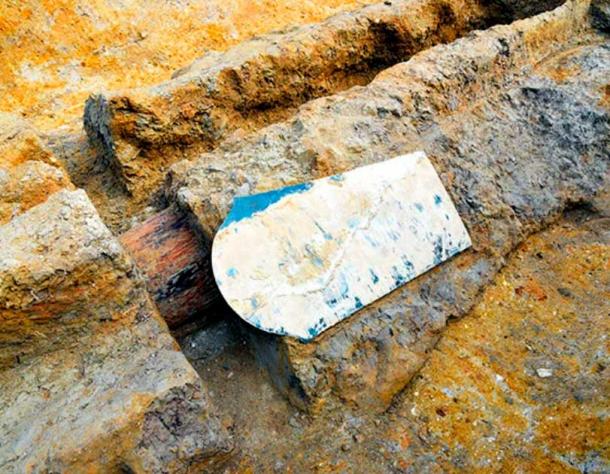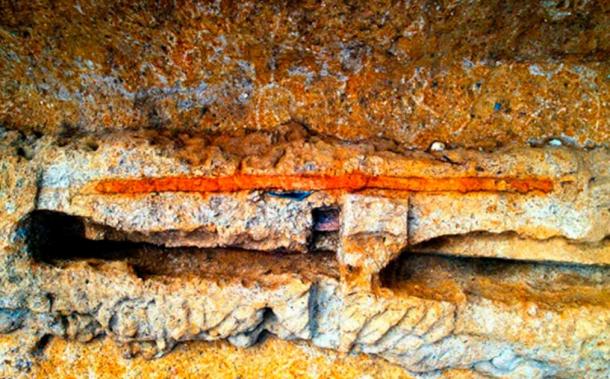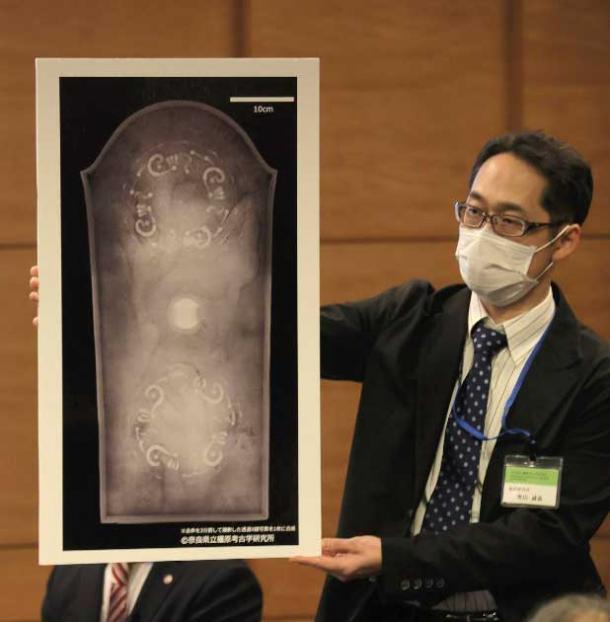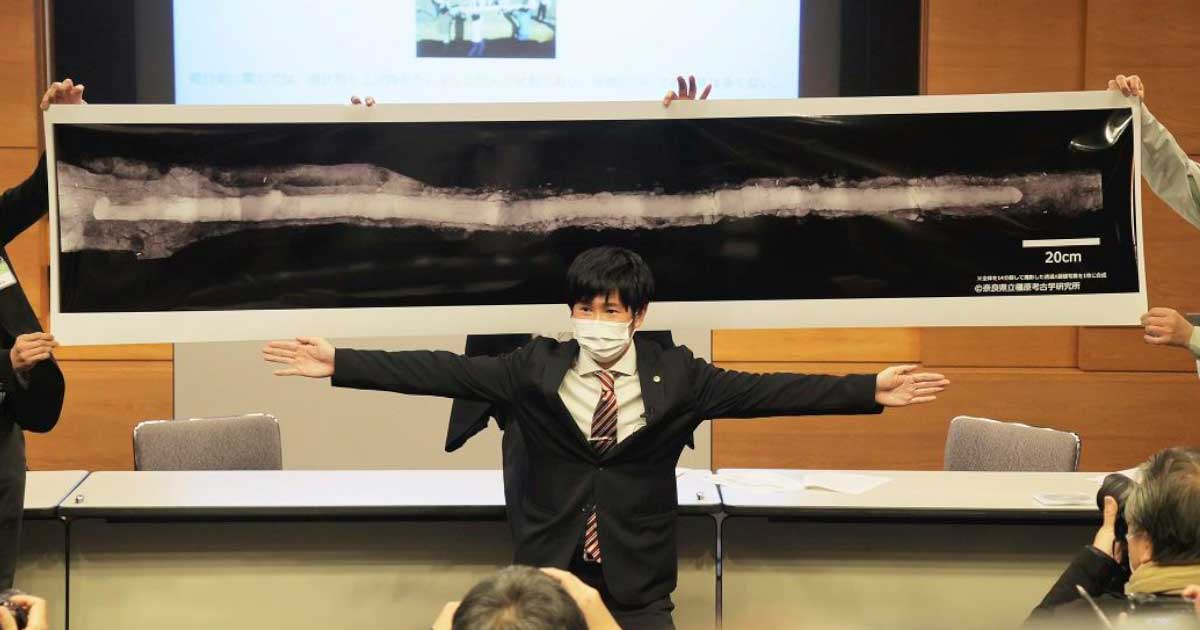Giant 7-Foot Sword and Mirror for Demon Slaying found in Japan Tomb
Researchers in Japan were excavating an ancient kofun burial mound when they found an enormous shield-shaped bronze mirror and a giant 7-foot iron sword, the largest that have ever been discovered on the Island.
On January 25th, researchers from the Nara Municipal Buried Cultural Properties Research Center and the Nara prefectural Archaeological Institute of Kashihara announced “unprecedented and exciting” new discoveries.
Prof. Seigo Wada, director of the Hyogo Prefectural Museum of Archaeology, who advised on the excavation, told ASAHI that a team was excavating Japan's largest round ‘kofun’ burial mound - the Tomio-Maruyama - that was created in the second half of the fourth century AD. Buried in clay at the very center of the ancient tomb, and placed over the deceased’s body, the very unusual giant sword and mirror were recovered.

The shield-shaped bronze mirror found in Tomio-Maruyama. Credit: Nara City Board of Education
A National First for Japanese Archaeology
The Tomio-Maruyama kofun has been under excavation since 2018. This year, researchers explored the “tsukuridashi,” a raised section at the center of the burial mound. The first major discovery came in the form of an enormous “5 metre (16.4 ft) long wooden coffin.” Then, buried in clay covering the coffin, the archaeologists identified the huge iron sword and shield-shaped bronze mirror.
Mirrors, having the power to reflect images and start fires, were deeply sacred objects in ancient times. Many mirrors were imported to the Japanese islands from China, where they became symbols of authority and were subsequently buried as funerary objects in elite tombs. This represents “the first time” that such a mirror has ever been discovered in Japan.
- Norimitsu Odachi: Who Could Have Possibly Wielded This Enormous 15th Century Japanese Sword?
- Researchers in Japan Discover the Secrets Behind Magic Mirrors and a Mysterious Shaman Queen

The giant sword found in the burial mound. Credit: Nara City Board of Education
A Masterpiece of Kofun Craftwork
Measuring around 64 centimetres (2 ft) long by about 31 cm (1 ft) wide, the back side of the bronze mirror is heavily-decorated with complex interweaving patterns. Its surface is described as “the largest” of any bronze mirror found at an archaeological site in Japan. Most often, bronze mirrors from ancient Japan are round, but this one is different in that it is shield-shaped. This is why the team of researchers describe it as “a masterpiece artifact” from the Kofun Period.
The center of the mirror is raised at the back which allows it to be picked up. The raised section is surrounded by circular patterns representing ‘other worlds’, and the ancient Japanese gods who were believed to inhabit them.
The archaeologists said these designs are “identical to the patterns inscribed on the Kofun period mirror known as "Daryukyo.” For this reason, the shield-shaped mirror has been called the "Daryumon shield-shaped bronze mirror."

Decorative patterns are seen in an X-ray photo of the shield-shaped bronze mirror. Archaeological Institute of Kashihara in Nara Prefecture.
A Magical Shield Was Useless Without a Gigantic Sword
The giant sword measures 2.37 metres (7.77 ft) long, by 6 cm (2.36 in) wide and has a snake-shaped blade known as a “dakoken." Representing “the largest intact sword” ever discovered at an archaeological site in Japan, because of its weight, it is thought unlikely that it was ever wielded in battle as a weapon. It is speculated that this enormous sword was manufactured specifically to serve as a weapon of spiritual warfare, for use in afterlife battles, where Oni (demons) and yurei (ghosts) strived to capture one’s journeying soul.
In conclusion, the researchers think the huge sword and shield were “ceremonial,” and placed in the grave as magical devices to ward off evil entities, and grave robbers. And it seems to have functioned well in this regard, for this huge Kofun tomb has never been broken into over its 1,600 years of existence.
Keying Into Japan’s Kofun Mounds
Keyhole-shaped, circular, or square Kofun burial mounds were commonly constructed during the Kofun period, which lasted from the 3rd to the 7th century AD. The inner tombs sometimes comprised simple pits, but others were complex structures comprising multiple chambers and corridors decorated with arts and sculptures. Kofun, however, were not for everybody who died; they were reserved for the burials of powerful leaders, members of Japan’s ancient ruling classes and societal elites.
In January last year, I wrote an Ancient Origins News article after a team of scientists mapped the alignments and orientations of hundreds of ancient Japanese Kofun keyhole-shaped burials. It was discovered that not some of them, but all of them, face the rising sun on the east horizon. The researchers said the act of lining up your tomb with the globe's axis “was a sign that you were still number one, and an attempt to assert family power, even in the afterlife”.
Another way to assert, and maintain power in the afterlife, was to assure that your tomb wasn’t broken into by grave robbers. And this is believed to have been the prime inspiration for burying the giant bronze shield-shaped mirror and iron sword.
The area of the Kofun where the shield and sword were found will be opened to the public on January 28th and 29th. However, The Nara city board of education said the giant mirror and sword will not be displayed, as they will be restored during the course of 2023.
Top image: An X-ray showing the relative size of the giant sword found in the Japanese tomb. Archaeological Institute of Kashihara in Nara Prefecture.
By Ashley Cowie


















Comments
“Another way to assert, and maintain power in the afterlife, was to assure that your tomb wasn’t broken into by grave robbers. And this is believed to have been the prime inspiration for burying the giant bronze shield-shaped mirror and iron sword.”
I guess this hasn’t worked too well since we’ve now broken into his eternal tomb!?
From stardust I was born, to stardust I shall return
Thanks for the picture links Mr. Wagner! I had no idea these were so large. I wish the author had included pics since most people won't read the comments.
I guess ridiculous explanations are contagious in the field. But no, these mounds were pre-Ice Age subterranean dwellings occupied by a totally different Atlantean-like culture that perished. In Japan, you’ll note a lot of megalith stone foundations, which were ruins before many were much later built upon with wooden castles of Chinese influence. Ancient Japanese texts mention the existence of the big stones, but not their quarrying or construction. So it’s just like so much of the world, bone-filled ruins of a long-lost ancient culture, resettled much later by a new people. But this find in Japan is a bit more curious, with respect the size of the sword and the huge man you might imagine carrying it.
All of these are in Japan: https://i.dailymail.co.uk/1s/2022/01/20/18/53174609-10423937-image-a-37_...
https://rekishinihon.files.wordpress.com/2013/01/screenshot_32.jpg
https://upload.wikimedia.org/wikipedia/commons/2/27/IshibutaiWithFigureS...
https://d.newsweek.com/en/full/813857/kofun-japan-42.webp?
Nobody gets paid to tell the truth.